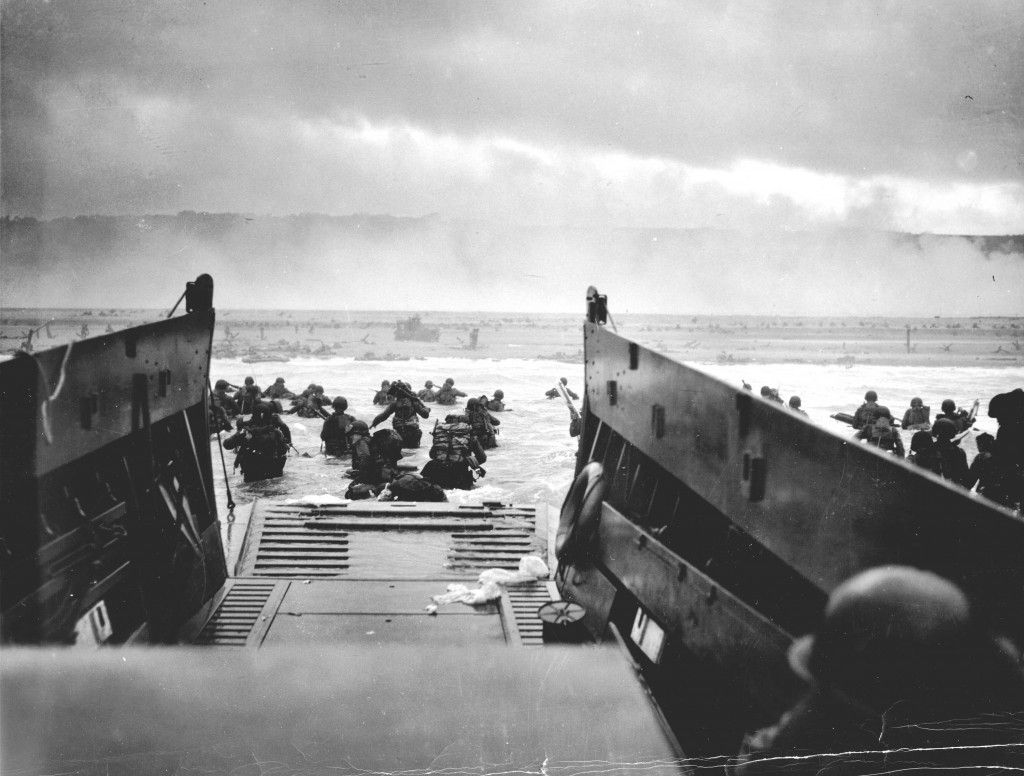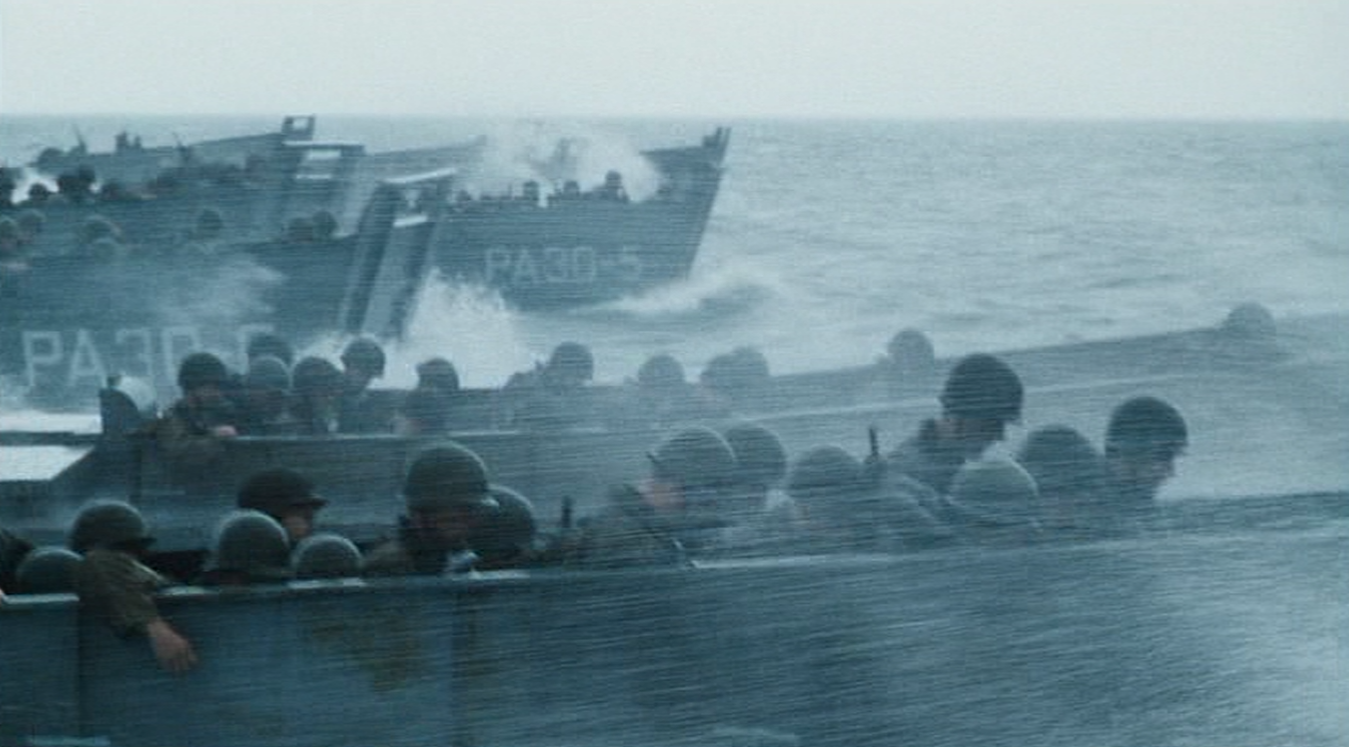

A solution is fire support boats, modified landing craft that come to shore together with the troop carrier landing craft. These are "buttoned up", with a minimal visible target, and extra protection. Watch how each stage subdues the German defenders just enough to get to the next stage.
For every 14 landing craft there are
Two rocket boats
One howitzer boat
Two machine gun / mortar boats
Nine troop carriers
Rocket boats have a rocket launcher with 60 rockets,
just like some Sherman tanks had.
They may be launched in salvos of ten rockets, direct fire.
I wouldn't want to be the coxswain.
A howitzer boat contains a 75-ml. pack howitzer FIXED. Unlike those pictures the gun has a shield, plus more walls around
the mouth of the boat so the crew is protected.
Mortars are walled off in their part of a landing craft.
The machine gun is a proper machine gun position, complete with sandbags
and probably overhead protection.
There is a two-man team with a water-cooled, belt-fed
machine gun.
During the approach to the beach the pack howitzers can start plinking away, in howitzer mode. Then the rocket boats can start their barrages, with the rocket launchers in fixed positions. Then the mortars would do a quick creeping barrage in the approach to the beach. How are those German arillery observers doing?
The rocket boats come just shy of hitting the beach with a last-moment barrage,
then leave.
The ramps go down on the howitzer boats, and the pack howitzers switch to direct fire.
The ramps go down on the machine gun boats, and the machine guns do their work, while
the mortars can hit their their targets on the the top of the bluffs.
The standard landing craft let loose the assault troops, they may fire off some rounds,
then leave.
After a mere four minutes landed on the beach, the howitzer and machine gun/mortar boats pull their ramps back up and leave.
Infantry would walk forward to the shingle, ideally with intact units and all their officers. The bangalore torpedo men, stripped of extra weight, would push on ahead, saving a bit of time once the assault troops reach the shingle. The infantry would provide fire support of their own, positioned half way between the shore and the sea wall - decent range for the bazookas. A couple of bazooka teams, a couple of b.a.r. teams, and I can't resist adding some riflemen. These would scoot forward to rejoin their units at the right time. Everybody get off that beach!
Don't forget the Navy men bravely trying to remove beach obstacles. Also Ralph is back there with a shrapnel wound, so the medic is on the beach, with the tide coming in.
The second wave, arriving half an hour later with no special tricks, would reinforce the first wave, who
would have eaten into enemy defenses.

It's fun to ponder how the fire support team from among the landed infantry
would work. But maybe that's the wrong approach.
Everybody get to the shingle and move off the beach!
The fire support boats could stay on the scene until the troops reached
the shingle, and perhaps set off bangalore torpedos.
The fire support boats would become increasingly better at identifying
and zeroing in on their targets.
On the other hand it would certainly come at a cost, as guns and mortars
would chew up the plywood boats one by one.
Should the boat ratios be tinkered with? Too many rockets?

The most dubious part of this plan is surely the rocket boats. They really did use (bigger, indirect fire) rocket boats on D-Day, and I figured it would be useful to have them right in the row of landing craft, sending a barrage at just the right time before landing. However, I don't know how well the boat people would survive this. I know that crew for German minenwerfer set off their weapon from some distance away, sitting in a hole in the ground. Is there a way of protecting the crew? The crew also needs to pilot the boat, and do so in line with the other boats. You don't want another boat to be behind or in front of you. The set of rocket tubes high up would make the boat top heavy.
How accurate would the fire support boats be? I can only guess the situation with smoke. You can find footage of troops disembarking on Juno Beach - you have seen this footage - and this shows the boat going back and forth, more horizontally than vertically. This would make a mockery of aiming at a target. If you're popping away with a machine gun or blasting your cannon in a bobbing boat, might you shoot the walking troops instead of the distant fortified enemy?
Troops in the landing craft bailed out water from their boats with their
helmets, and some boats did sink. The fire support boats would be in the
same conditions, with fewer people to bail.
I'm not sure I'd want to share a dinky boat in choppy waters with an
artillery piece.
It doesn't help that the crews would be cold, wet, seasick, scared, under fire, just like the troops.
How about the energy of a pack howitzer being
pushed back? Might that knock the boat loose? Can something be done about
that?
Modified
Say goodbye to the infantry fire support teams while approaching the shingle. If there are such teams, they are not going to be using bazookas.
Fire support boats should stick around until the infantry walks to the shingle (running ain't gonna happen), which would take longer than you think. Their fire would be rather random. The boats could become targets themselves, but it's worth it to try to get that first wave successfully rolling forward.
I guess we're using the bigger 80 mm. mortars.
Machine guns on the fire support boats can't be all that useful. Maybe don't bother with them.
If you are using them, consider 1. The gun nuts can figure out if a higher-calibre machine gun is
preferable 2. Can you/should you shoot off to the side? 3. Friendly fire,
shooting from a low position.
Unlike tanks, you can be assured that the fire support boats would be available at the same time and place as the craft landing troops.